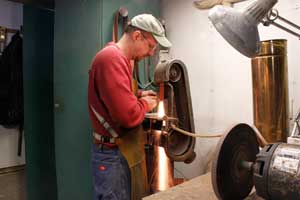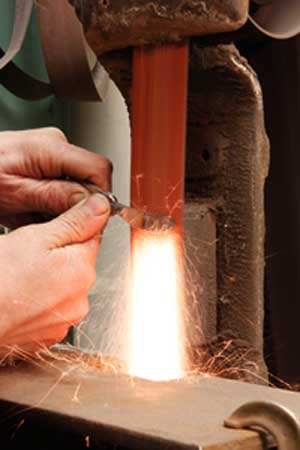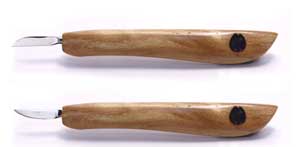
Paul Jones’s shop is a 20 x 20 garage, packed with tools like a table saw, band saw, drill press, drum sander, flap sander and dust collectors, all 20 feet away from northern Minnesota hardwoods. “If you didn’t look close, you would think it was a furniture shop,” he said.
If you did look closely, however, you’d find a few distinctive tools: a belt grinder, an anvil and a 2,200-degree propane gas forge, all used in creating the thousands of woodcarving tools Paul creates in the shop.
Since he began selling his knives in 2005, Paul estimates he’s made between 4,000 to 4,500 carving knives, sent to customers all over the world. Over his lifetime, and counting those he’s given away to family and friends, the number is closer to 6,500.
“I’ve been a woodcarver since I was 12 or 13,” Paul said. “My father used to work for Potlatch [a paper, lumber and forest management company], and he’d bring home hacksaw blades. I’d make my own carving knives down in the shop with my dad. It soon progressed to being more interested in the tools rather than in carving.”
Paul does admit, having recently run across a knife he made when he was 17, that 30-plus years later, “I don’t think I’d pass it off as mine.” He has managed to learn a great deal along the way, using the Internet as a resource for using blacksmithing skills, for example. “I’ve learned a lot more advanced metallurgical techniques: hardening steel, not burning steel — it’s amazing what I’ve learned about steel, and the task you’re designing for.” For example, if a tool needs to be more rigid, it needs to be made of a harder steel.
Mostly, Paul said, he works with a tool design “until I got it right, and it passed my own tests of what a good tool should be.” That includes being both tough and sharp, and the blade “with a return kind of like a spring, so that it will flex but not break — and will stay sharper longer.” He also polishes to a higher degree than other knife makers, because, he said, “I find a polished knife makes a lot smoother cut, and lasts longer.”
Plus, Paul said, he wants to make an “aesthetically pleasing knife.” Often, that means using burls, or wood from the crotch of a tree. With the network of loggers and portable sawmill owners in northern Minnesota, who can’t run these types of wood through their machines, “Once people found out I was looking for stuff, I haven’t had to harvest my own for a couple of years.”
Lately, Paul has been working with black walnut crotchwood with “stump flare” — wood from where the tree comes down and flares out to go to the roots of the tree. “It’s like fiddleback maple, except walnut.” The color, he said, “reminds me of when you stir the creamer into your coffee. When you put the finish on, it really pops, and you get the depth of the wood.”
Finishing, Paul says, “is one of my parallel passions — figuring out how to get the wood to do what you want it to do.” For a long time, he used a polyurethane finish, but currently prefers Tru-Oil® Gun Stock Finish from Birchwood Casey. “It really accents the depth,” he said. He’s experimening with dyes and heat to get the ripple to “pop” in a pile of fiddleback maple — and, some time, when he has some more time to play, Paul would also like to experiment with lacquers.
One reason Paul doesn’t have that time right now is that his knife making business is done around a “day job” in marketing for a garage door company. He works in that office four days a week, and on Mondays, spends 12 to 14 hours in his shop making knives. On other evenings, “After I get home from work and kiss the wife and tickle the kids, I come out to the shop for another two or three hours.”
One of the ways he determines what to make is customer demand. Paul does make custom carving tools: “maybe somebody has a tool that their grandfather had and it’s finally worn out, but they know what it looks like, or what it should look like.” After he’s showed it around, “If there’s enough demand, I will start making that tool.”
For instance, the “Draper Detailer,” is a knife that Paul describes as “fun to make,” with a plain, flat blade that fits well into the Scandinavian style of carving. His friend Monte Draper, a well-known carver in the local area, “grabbed the design up and said, ‘This is what I’ve been looking for!’,” then took the knife to a carving meeting. “I got a lot of orders after that,” Paul said — and he named the knife after his friend.
Orders go in spurts, Paul said. He can be making 10 to 15 knives a week in one model, “and then somebody on some blog will say something nice about another model, and it will go crazy for that model.” The String Beaner, a 6-1/2″ long knife with a cutting edge of 3/4″ or 1″, is a good example: “I’ll go forever without making any, then I’ll be making ’em until I’m sick of looking at ’em.”
Some of those orders come from customers in countries as far-flung as Australia, Iceland, Hong Kong, Ireland and Greenland. “It always amazes me that these are people who are just down the road from some of the foremost blacksmiths and toolmakers, and they’re ordering from me, which is a huge compliment,” Paul said.
He continues to find challenges in the work: the Spoon Knives, for example, are “by far the most difficult to make,” he said. “They require a consistent bend, and it’s difficult to grind the edge into a curve and keep it working the way it should be. For every five spoon knives I make, one goes in the scrap bin, because I’ve ground it down too far or I can’t seem to get the correct bevel edge on it.”
He also has fun — with the tools he makes and the ones he uses. His belt grinder, for instance, came from a scrap yard. “I was looking for a part for a riding lawn mower, and I tripped over this goofy thing. It was cast-iron; it took everything I had to lift it.” Now, it sits in his shop, among the “little blocks of wood everywhere that are things I think would make good handles for stuff.
“All I’ve done is pursue my passion,” Paul said. “Don’t worry about money or what people think; it if truly is your passion, it will show in your work, and your work will be in demand.”










